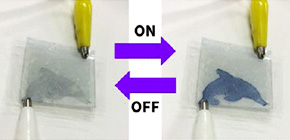
Electronic paper made of “real” paper
Osaka University-led researchers developed technology to combine “a transparent paper” with high transparency (90% of visible-light transmittance of paper made from cellulose nanofibers) and a conventional “white paper” made from cellulose pulp fibers, fabricating a highly transparent electrode and a white electrolyte with high visibility. Through the combination of the electrode and electrolyte, they produced paper-based electrochromic (EC) displays. Their research results were published in ACS Applied Materials & Interfaces .
In EC devices, when voltage is applied to a transparent EC electrode, ions or electrons move into the EC layer in the electrolyte (ionic liquid), resulting in coloration or decolzoration. However, conventional EC devices had problems: sealing was necessary for preventing leakage of the electrolyte, making thin films was difficult, and EC performance was compromised due to evaporation of the electrolyte.
A group of researchers led by Hirotaka Koga succeeded in preparing a paper electrolyte by supporting a non-volatile electrolyte (1-butyl-3-methylimidazolium tetrafluoroborate [bmim]BF 4 ) on the surface of cellulose pulp fibers through hydrogen bonding. Furthermore, they evenly coated conducting polymers with EC function, poly(3,4-ethylenedioxythiophene) poly (styrenesulfonate) (PEDOT:PSS), onto the entire surface of the transparent paper made from cellulose nanofibers, fabricating a transparent EC paper electrode.
By sandwiching the as-prepared LiClO 4 /[bmim]BF 4 @paper electrolyte between EC conductive PEDOT:PSS-coated transparent cellulose nanofiber papers (denoted as PEDOT:PSS@nanopapers) as a transparent EC electrode, this group fabricated an EC paper device.
This EC device not only resolves the above-mentioned problems, but is also flexible and easily bent because the whole device is paper-based. In addition, a white paper electrolyte with high optical reflectance enhances the visibility of the EC displays.
The researchers have created a new application for paper, which has traditionally acted as a medium on which to display information by writing and printing, as a display using electricity. They have succeeded in developing various paper-based electronic devices, such as memory, transistors, antennas, and supercapacitors. If these technologies are integrated, it will become possible to produce paper-based electronic books as well.

Figure 1. An electrochromic display based on transparent paper electrodes and a paper electrolyte.

Figure 2. Schematic of conventional electrochromic display (left) and electrochromic paper display (right).
To learn more about this research, please view the full research report entitled "Ionic Liquid Mediated Dispersion and Support of Functional Molecules on Cellulose Fibers for Stimuli-Responsive Chromic Paper Devices" at this page of ACS Applied Materials and Interfaces .
Related links
